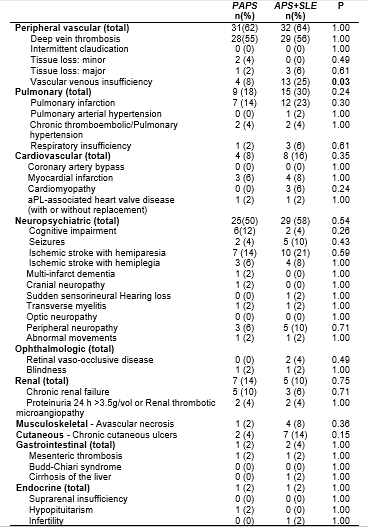Session Information
Session Type: Poster Session (Sunday)
Session Time: 9:00AM-11:00AM
Background/Purpose: Antiphospholipid syndrome (APS) is an acquired thrombophilia that affects young productive individuals with permanent damage and negative impact in quality of life. Recently a damage index specific for APS (DIAPS) was developed. There are, however, no data regarding the comparison of its performance and long-term damage in primary antiphospholipid syndrome (PAPS) and APS related to SLE (APS+SLE). The primary purpose of this study was, therefore, to compare the long-term damage in patients with these conditions.
Methods: This is a retrospective analysis of a single tertiary center cohort followed for approximately 10 years, using a standardized prospective electronic chart database. Fifty consecutive PAPS patients age matched with fifty APS+SLE patients were consecutively selected for the study and DIAPS was calculated once-a-year during follow-up. Long term damage and damage kinetics in both groups were compared.
Results: PAPS and APS+SLE had comparable age (47.10±12.4 vs. 44.04±10.80 years, p=0.19) and time of follow-up (9.40±3.60 vs. 10.94±4.50 years, p=0.06). At diagnosis, PAPS group had higher DIAPS than APS+SLE (1.72±1.17 vs. 0.82±0.96, p< 0.001). At the end of 10 years follow-up both groups presented comparable mean damage scores (2.04±1.50 vs. 2.24±1.61, p=0.52). The damage increment throughout the observation period for PAPS was solely 35% whereas for APS+SLE it was gradual, persistent and reached 139% at the end of follow up with a total damage increment for PAPS lower than APS+SLE group (0.43±0.30 vs. 1.22±1.24, p< 0.001). Of note, the frequency of individuals that acquired damage was lower in PAPS than in APS+SLE group (32% vs. 71%, p< 0.001). PAPS had also longer delay in diagnosis than APS+SLE (4.00±4.20 vs. 2.54±3.05 years, p=0.04). This delay was positively correlated to a higher damage score at diagnosis (r=0.36, p< 0.001) in all groups.
Conclusion: We identified a distinct pattern of damage in PAPS and APS related to SLE. Damage in PAPS is an early event while APS+SLE is associated with higher long term damage with a striking increment of damage along the follow-up. Diagnosis delay is correlated with higher damage scores. Damage surveillance requires therefore different approaches for these two conditions.
To cite this abstract in AMA style:
Kühl Torricelli A, Remião Ugolini-Lopes M, Bonfa E, Andrade D. Antiphospholipid Syndrome Damage Index (DIAPS): Distinct Long-term Kinetic in Primary Antiphospholipid Syndrome and APS Related to SLE [abstract]. Arthritis Rheumatol. 2019; 71 (suppl 10). https://acrabstracts.org/abstract/antiphospholipid-syndrome-damage-index-diaps-distinct-long-term-kinetic-in-primary-antiphospholipid-syndrome-and-aps-related-to-sle/. Accessed .« Back to 2019 ACR/ARP Annual Meeting
ACR Meeting Abstracts - https://acrabstracts.org/abstract/antiphospholipid-syndrome-damage-index-diaps-distinct-long-term-kinetic-in-primary-antiphospholipid-syndrome-and-aps-related-to-sle/



